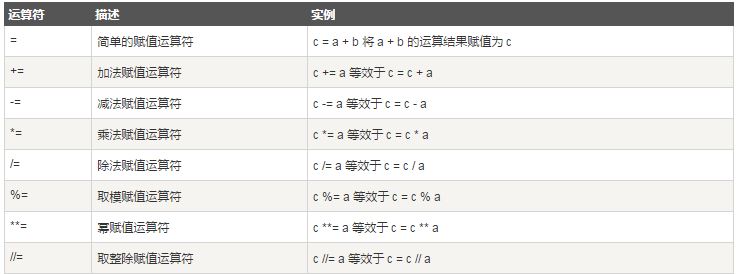
Python 变量类型
变量存储在内存中的值。这就意味着在创建变量时会在内存中开辟一个空间。
基于变量的数据类型,解释器会分配指定内存,并决定什么数据可以被存储在内存中。
因此,变量可以指定不同的数据类型,这些变量可以存储整数,小数或字符。
变量赋值
Python中的变量不需要声明,变量的赋值操作既是变量声明和定义的过程。
每个变量在内存中创建,都包括变量的标识,名称和数据这些信息。
每个变量在使用前都必须赋值,变量赋值以后该变量才会被创建。
等号(=)用来给变量赋值。
等号(=)运算符左边是一个变量名,等号(=)运算符右边是存储在变量中的值。例如:
#!/usr/bin/python # -*- coding: UTF-8 -*- counter = 100 # 赋值整型变量 miles = 1000.0 # 浮点型 name = "John" # 字符串 print counter print miles print name
以上实例中,100,1000.0和"John"分别赋值给counter,miles,name变量。
执行以上程序会输出如下结果:
100 1000.0 John
多个变量赋值
Python允许你同时为多个变量赋值。例如:
a = b = c = 1
以上实例,创建一个整型对象,值为1,三个变量被分配到相同的内存空间上。
您也可以为多个对象指定多个变量。例如:
a, b, c = 1, 2, "john"
以上实例,两个整型对象1和2的分配给变量a和b,字符串对象"john"分配给变量c。
Python赋值运算符
以下假设变量a为10,变量b为20:

以下实例演示了Python所有赋值运算符的操作:
#!/usr/bin/python a = 21 b = 10 c = 0 c = a + b print "Line 1 - Value of c is ", c c += a print "Line 2 - Value of c is ", c c *= a print "Line 3 - Value of c is ", c c /= a print "Line 4 - Value of c is ", c c = 2 c %= a print "Line 5 - Value of c is ", c c **= a print "Line 6 - Value of c is ", c c //= a print "Line 7 - Value of c is ", c
以上实例输出结果:
Line 1 - Value of c is 31 Line 2 - Value of c is 52 Line 3 - Value of c is 1092 Line 4 - Value of c is 52 Line 5 - Value of c is 2 Line 6 - Value of c is 2097152 Line 7 - Value of c is 99864




